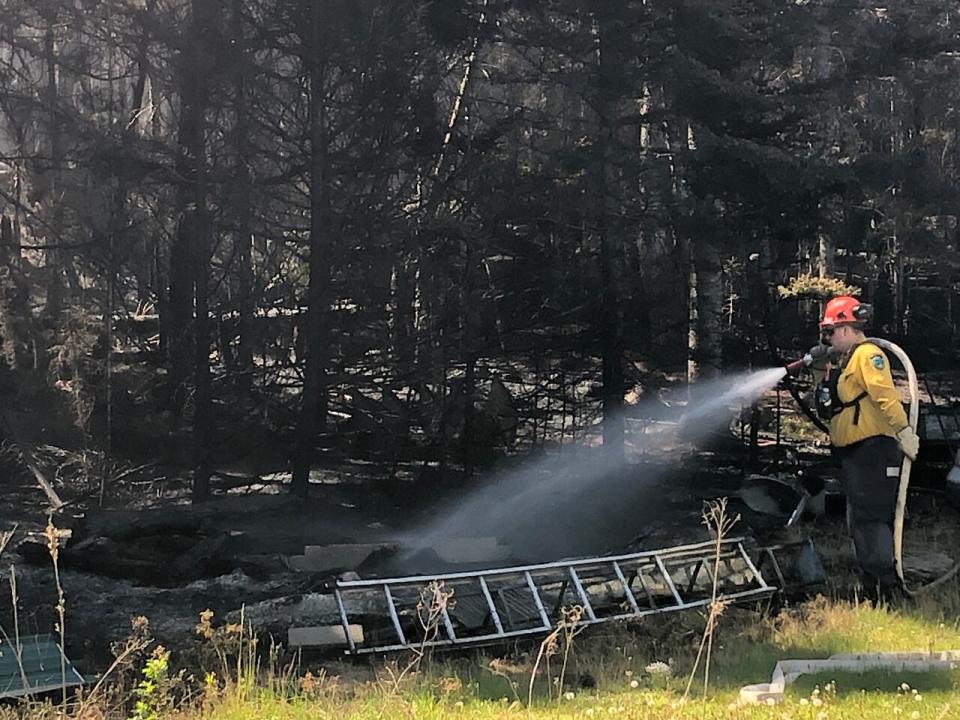Town of Riverview looking into how to protect homes from wildfires

In backyards along Goldsboro Avenue, trees rise only a few metres from homes. Privacy, shade and nature.
But the forest in this Riverview neighbourhood is among the areas the town's fire department has pointed to as at risk in a wildfire.
It's a risk that came into sharp focus almost a year ago when a fire in a yard swept through woodland, homes and businesses on the outskirts of Halifax.
It's the type of area firefighters describe as a wildland urban interface, the place where human development meets the natural environment.

The wildfire near Barrington Lake last year was the largest on record in Nova Scotia, burning 23,525 hectares. (Communications Nova Scotia)
"We're worried about any possibility of the areas here having the same [situation]," John Malloy, deputy chief of fire prevention for Riverview Fire Rescue, said of fires like those in Nova Scotia and southwestern New Brunswick last year.
On Saturday, the fire department will host a public meeting to talk about how property owners can reduce the threat.
WATCH | What to look for to reduce wildfire risks around your home:
The fire department has pointed to several areas, including Highgate Court, Goldsboro Avenue, Irving Road, Lawson Road and Rivereast Drive, as at higher risk because of proximity to woodland, along with Mill Creek Nature Park.
The information session, from 10 a.m. to 12 p.m. at the fire hall, will also include representatives from the provincial Department of Natural Resources and Energy Development.
Last fall, Emma Farnham was hired as the department's FireSmart co-ordinator.
FireSmart Canada is an organization that offers information to homeowners and communities on how to better protect a home in the event of a wildfire. The town received a $500 grant from the organization, which it will use for the Saturday event.

Emma Farnham, a FireSmart co-ordinator with the provincial Department of Natural Resources and Energy Development, will be part of the meeting Saturday. (Shane Magee/CBC)
Farnham's position involves working with fire departments such as Riverview's, and FireSmart Canada, to examine which communities in the province are at risk of wildfires, prioritize them and implement plans to address that risk.
"Riverview just happens to be one of the go-getters that are kind of going above and beyond and have been working with us, FireSmart Canada, for a couple years now just to get ahead of the ball game, which is something that all communities should be following," Farnham said in an interview.
Last year's wildfire season was one of the worst on record based on a number of metrics. After one of the warmest winters on record, the federal government warned the country could face another disastrous fire season.
New Brunswick's forest fire website says 112 fires have been reported across the province so far this year, compared to 67 at the same point last year. The 10-year average is 53 fires.
This year fires have burned 124.8 hectares so far. Last year, 857 hectares burned, with about 500 of those the Stein Lake Fire near Saint Andrews. One home was destroyed in that fire.
Back in Riverview, in a backyard along Goldsboro, Malloy and Farnham pointed out several ways to help protect a property.
They noted gravel around the edge of the house, which reduces the chances of ignition compared to mulch or shrubs.

A firefighter helps douse Stein Lake Fire hot spots near Saint Andrews last year. (Mia Urquhart/CBC)
However, they also noted a wooden fence goes right up to the edge of the house, and there are several trees in close proximity. Pine and fir trees, with their needles, are more susceptible to fire.
Materials used for siding and roofs, as well as some roofing materials, are also factors to consider, Malloy said.
Wood and vinyl can burn easier than asphalt or metal. Alleys in a roof can act as a place for embers to land and burn.
Both hope residents will come out Saturday to hear more about steps they can take to help protect their properties.


